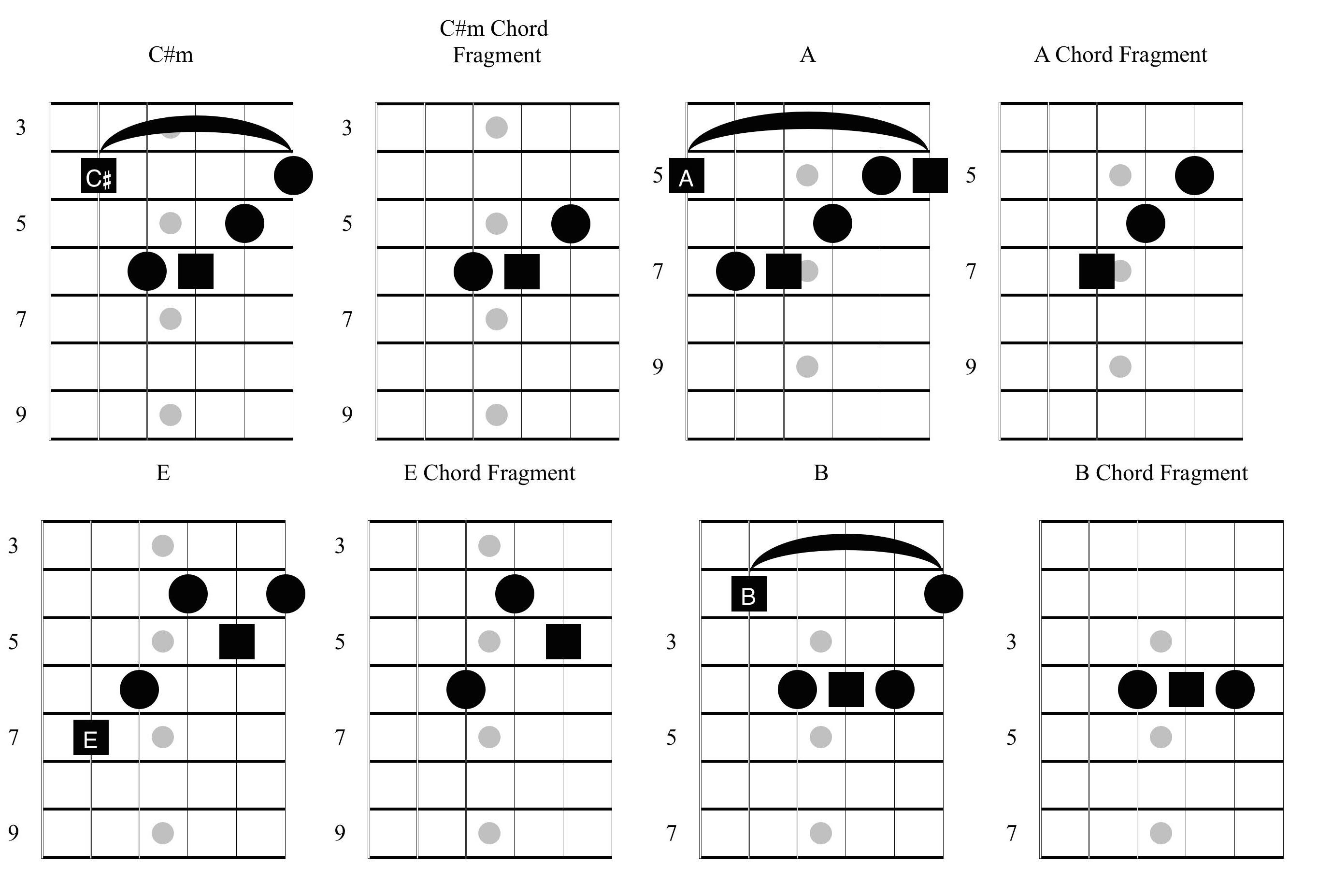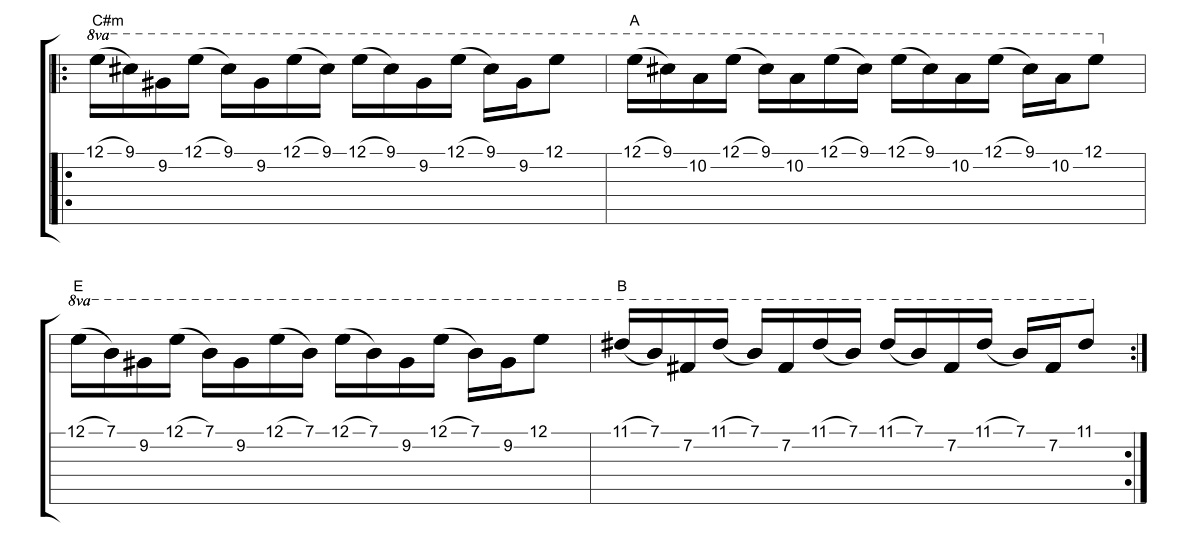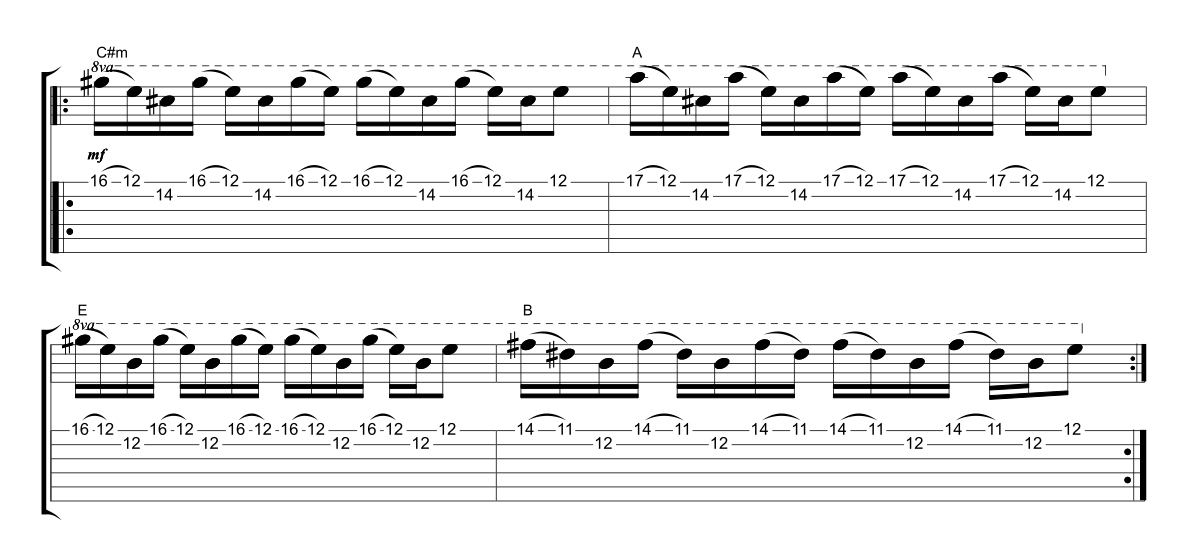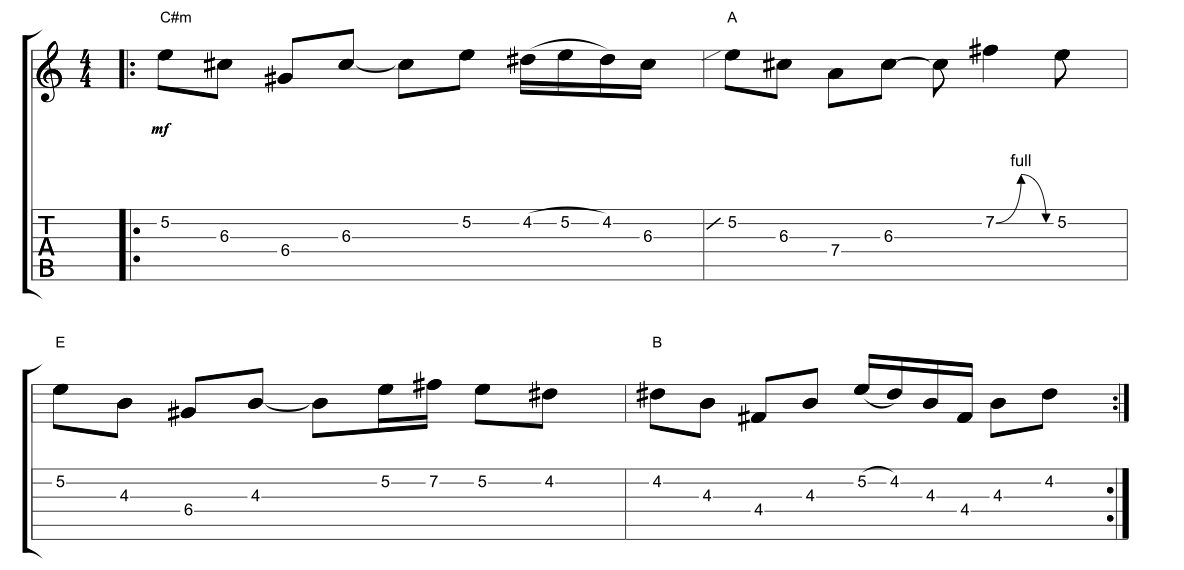Creating Memorable Arpeggio Solos
In today’s lesson, we examine the use of arpeggios in creating memorable solos. Simply put an arpeggio is the notes of any given chord played one at a time, or a broken chord. So it makes perfect sense that when you have a chord sequence using the corresponding arpeggio for each chord will fit perfectly. Example one demonstrates how to build small arpeggios from chords, and example two and three show you an Eagles style arpeggio pattern in the style of Hotel California!
Melodic Guitar Soloing Example 1 – Arpeggios From Chords
The chord progression used today is the same as in the previous lesson and is based around the chords of C#m, A, E and B. Example one demonstrates that you can build three note triad arpeggios built from each of those chords. I have added a melody line to each triad to create the lick, but the core element throughout is the underlying chord shape played one note at a time as an arpeggio. Shown below are the full chord shapes of C#m, A, B and E in the specific voicings used to create this lick. Next to each full chord shape I have put the three note shape you can use for example one.

Melodic Guitar Soloing Example 2 – Eagles Style Arpeggios 1
There are few solos as classic as the incredible Hotel California. One of the most memorable aspects of the solo is the outro arpeggio section. This repeated arpeggio pattern on the high E and B strings follows the underlying chords perfectly and applies pull-offs to create a legato feel. Example two is reminiscent of that outro solo section and applies a top two string approach to soloing over the chord progression (mentioned in example one).

Melodic Guitar Soloing Example 3 – Eagles Style Arpeggios 2
Example three follows on from example two but uses different mini arpeggio shapes higher up the neck. On the original Hotel California record, there were two arpeggio harmony parts played at the same time in the outro solo. This example can be played alongside example two to replicate that wonderful sound.

Recommended listening
For classic Easgles style guitar licks, I recommend buying the album “The Eagles – Greatest Hits.” My favourite track on that album being “Hotel California.”
Subscribe on Youtube
Make sure you log on and subscribe to our new YouTube Channel, dedicated to bringing you the finest free guitar lessons.
Guitar Lesson Video Transcription
Hi YouTube, Simon here once again for the amazing Fundamental Changes. Today we’re looking at our Creating Memorable Solos part 2, and it’s all about mini arpeggios, one of my favourite techniques. Let’s go and have a look at 3 examples, just after this.
[guitar playing]
There was lick 1 there. These chords, and the backing along with this are the same with the previous lesson. If you didn’t see that, those chords are C sharp minor, A, E, and B.
What we’ve done here is we’ve broken down these chords into little 3-note chunks, and then built a little riff around each one of those chords. Now, these chord diagrams will be on Fundamental Changes along with the article in the description below.
Basically, what you’ve got is your full chord in these examples here. Your C sharp minor will be your 4th fret bar chord with your A minor shape there, your A major bar chord which will be your 5th fret E shape bar chord there.
Your E bar chord, which I’m using the C shape – so 4th fret barring through, and then a C on the top of it – and then a B major there that I’m using 2nd fret with the A shape.
What I’ve done is taken the strings 2,3, and 4 of each of those little chords, and made little arpeggio pattern out of it by picking through the strings, and adding in just a couple of notes of the scale to give it a little bit more of a riff, lick type flavour there as well.
I played that one for you full speed and slowed down, but it’s really nice thing to do to look at your bar chords and to chunk them into little mini bite-sized chunks. Then you can pick through those and make little licks that will always work over the chord sequence, because it is the chord, just tiny little chunks.
Remember, arpeggio simply means broken chord. So the notes of chords one at a time played there. That’s Example 1 just around these little mini arpeggios. Let’s look at Example 2.
[guitar playing]
In terms of iconic solos, I don’t think it gets much more famous than Hotel California. If you don’t know the Eagles’ song Hotel California, go and check that out now, as that is absolutely essential guitar-listening.
The most famous bit of this solo, really, is the outro. What the outro is an arpeggio over the chord sequence that goes underneath it. What I’ve create here today are Examples 2 and 3, they can be played on top of each other as they are a harmony, or they are the same notes but played a distance apart. They work well together of each other.
What we’ve got is top 2 strings pulling off on the top string each time through different notes throughout these different shapes, and then blending the note on the 2nd string in with that little pull off, to give that little mini arpeggio.
Now the 1st two in this Example 2 are fairly okay. You’ve got 12-9 pull off on the top, 9 on the 2nd string, then 12-9-10. The third one, which goes with the E, is a bit more of a stretch, you’ve got 12-7-9, stretch those fingers out.
If you can’t manage the pull off, pick them individually. That’s a little tip there. If the pull off isn’t quite going, pick them through individually along with the tab there. The last one, same again, if you can’t manage to pull off, pick them individually. 11-7-7 for the B there – quite fun little mini arpeggios there.
They sound fantastic, they work beautifully with the chords, and also remember you can start to blend these in with lesson 1, where we’ve got the melodic lines as well.
Once you start to build melodic lines and arpeggios, you can start to see how you can build these more memorable solos by using solid principles, or fundamental principles if you like there(to drop in a little catch phrase).
Let’s go and have a look at Example 3.
[guitar playing]
Example 3 is an identical picking pattern with the pull offs to Example 2, and it can be played at the same time, as I said, as Example 2, which is done in a similar way to the original Hotel California record that this idea came to me about building memorable solos.
This time, we’re a bit high up on the neck, you’ve got 16-12-14, 17-12-14, pulling off, 16-12-12, and then 14-11-12 there on the top 2 strings as well. Make sure you watch the full speed and the slowed down version of each of these as well.
Hopefully today you can see the building mini arpeggios – We’re not talking about sweet picking, 6th string tapping-y stuff here, we’re talking about little fragment arpeggios that you can bring out, and that are useful across the whole board there as well.
What I should also point out is that you’ve got different shapes. This shape at the top string here, the original one we had in example 2, 12-9-9, is a minor shape. It’s going along with the chord sequence underneath it, C sharp minor, etc, etc, etc, etc.
Make sure you link up the chord that you’re playing over with that arpeggio shape, and then you can try moving these into different keys. Move everything back 2 frets and you’re in B minor, another 2 frets and you’re in A minor.
You can try out these little mini arpeggios and they’ll sound really fun. Other examples of course, include Dire Straits, Mark Knopfler likes to use these a lot in Sultans of Swing. There’s a passage near the end where he uses (guitar strumming), very, very similar ideas and principles to this lesson, classic soloing, classic melodic rock.
Hope you’ve had fun. Any questions, please leave it in the comments section below and I’ll be back very soon for part 3 of this Memorable Solos. Take care. See you soon.
Hi everyone, thanks for watching this video. I really hope you got something from it for your guitar playing journey. If you can go and check out Joseph’s books on Amazon, he’s got some fantastic ones over there for you to go and have a look at, his lessons, and all of his lessons on his site Fundamental Changes, and come and have a look at my YouTube channel SDPguitar for way more free videos.
Take care, I’ll see you next time.
“The artists you work with, and the quality of your work speaks for itself.”
Tommy Emmanuel
© Copyright Fundamental Changes Ltd 2024
No.6 The Pound, Ampney Crucis, England, GL7 5SA

